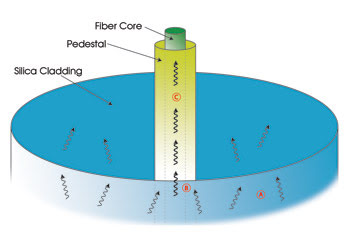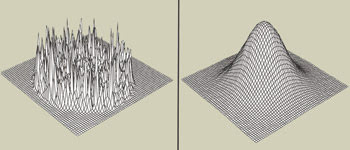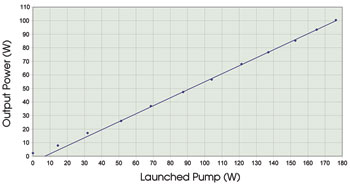las, small size and inherent fiber optic beam delivery are a few of the advantages for medical applications.
Dr. Carl Crossland and Gavin Frith, Nufern
The use of lasers as medical instruments has increased dramatically in recent years because of the growing acceptance and efficacy of laser procedures as an alternative to traditional surgeries. A recent market report by Frost & Sullivan, a research firm in London, predicts that the European market for medical lasers will nearly triple by 2013 to approximately $862 million US with ophthalmic, aesthetic, cardiovascular and urologic applications driving the growth.
In contrast to traditional surgery, fiber optic-delivered lasers can perform minimally invasive procedures. By selecting the appropriate wavelength, lasers can target specific molecules within tissue, such as hemoglobin, melanin or water. Controlling the intensity and duration of the laser output allows the surgeon to deliver the most appropriate amount of energy to achieve the desired effect. Because lasers offer such flexibility in these areas, they have gained widespread acceptance for use in lasik eye surgery, as a surgical tool for soft-tissue cutting and cauterization, in calculus removal in dentistry, in the ablation and dissolution of varicose veins, in kidney stone fragmentation and for the treatment of benign prostatic hyper-plasia.

Figure 1. This cross section shows a fiber with a pedestal design. Multimode laser energy at 793 nm is pumped into silica cladding (A). Thulium ions in the core convert each pump photon into two signal photons at 2000 nm (B). Signal beam is diffraction-limited because of the pedestal design (C).
Fiber lasers offer several advantages over other types for use in medical procedures, including smaller size, higher efficiency, superior beam quality, inherent fiber optic beam delivery and the potential for air-cooled operation. The most common fiber lasers are made from ytterbium-doped fiber, but because they operate in the 1-μm-wavelength region, their use has been limited primarily to materials processing applications. Recent advances in thulium-doped fiber technology have enabled manufacture of lasers in the 2-μm region that can deliver high CW power. Power levels exceeding 100 W are now achievable, and because of the broad emission spectrum of thulium-doped fiber, the lasers can be tuned to a particular wavelength within the 1900- to 2100-nm range. This range overlaps with a strong molecular water absorption peak and may therefore offer doctors the ability to “tune on” or “tune off” the peak, depending on the application and the depth that they require the laser energy to penetrate.

Figure 2. On the left is a multimode beam with low, poorly focused beam quality. On the right is a diffraction-limited beam that has high beam quality.
For high-power operation, Nufern engineers have designed a laser around a thulium-doped silica fiber with a 25-μm-diameter core and a 400-μm-diameter inner cladding. The fiber contains a unique raised inner cladding pedestal to provide a low (~0.1) numerical aperture between the core and the pedestal (Figure 1). By controlling the numerical aperture in this way, the fiber produces near-diffraction-limited beam quality, which allows a surgeon to focus the laser output with great precision (Figure 2).
Bragg gratings were spliced to the active thulium-doped fiber to create the laser cavity and to provide fixed wavelength operation. To yield output at 2 μm, the fiber was pumped with 200 W of 793-nm energy. The fiber’s relatively high thulium concentration produced a cross-relaxation effect whereby one pump photon yields two signal photons. This effect allowed the fiber to yield an overall optical conversion efficiency reaching 59 percent (Figure 3).

Figure 3. Fiber with a relatively high thulium concentration yields an overall optical conversion efficiency of ∼60 percent.
The emerging thulium-doped fiber laser technology may offer an effective approach to surgeons and doctors looking to control the energy absorption of water within tissue. Their high efficiency, small size and inherent fiber optic beam delivery make them a potentially attractive tool in the growing field of medical lasers.
Meet the authors
Gavin Frith is a senior engineer, and Carl Crossland is a product manager at Nufern Inc. in East Granby, Conn.; e-mail: [email protected].